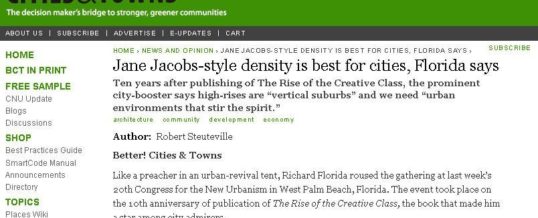2012May
"SF Startup Survival Guide: How to Find an Apartment in San Francisco"

Congratulations! You’ve taken the plunge and decided to move to San Francisco for your own startup or to join one of the hundreds (thousands?) here. Making the decision to move may have been difficult, but nothing compared to all the hassles and headaches of moving to this city.
Having just gone through this and spent a significant amount of time asking friends for advice on making the move, I’d like to share the best advice I received and what I learned myself. For reference, most people take months to find a place to live and move in. With the tips below, I found an apartment and moved in within 2 weeks of landing in SF.
...More"Jane Jacobs-Style Density is Best for Cities, Florida Says"

Like a preacher in an urban-revival tent, Richard Florida roused the gathering at last week’s 20th Congress for the New Urbanism in West Palm Beach, Florida. The event took place on the 10th anniversary of publication of The Rise of the Creative Class, the book that made him a star among city admirers.
“Isn’t it interesting that the world has come to us?” he asked the gathering of 1,100 urbanists. “Something has changed to make this part of the great challenges of our time. … I thought I was out in the wilderness, but it’s happening everywhere.”
...More"Selling the Pared-Down Life: The Founder of TreeHugger and His Apartment of the Future"

It may be that the house of the future is an apartment — at 420 square feet, a very small apartment — in a century-old tenement building on Sullivan Street. Shiny and white, it has movable walls that allow it to morph from one room into six, as well as expandable furniture and filtered, or “country,” air, as the owner, Graham Hill, put it recently while showing off the apartment’s convertible tricks like a modern-day Bernadette Castro, dressed neatly in a black merino wool polo shirt, black pants and black Vans.
This laboratory, as Mr. Hill calls it, for small-space, sustainable and — it must be stressed — high-end living is the first tangible product from his fledgling company, LifeEdited.
...More"Rental Competition Fierce in S.F.’s Market"

Michael Austin and Emily Morrison aren’t highly paid tech workers. He’s an actor with a day job as an administrative assistant; she’s an arts teacher at CalShakes. Newly engaged, they’ve been seeking an apartment in San Francisco to move into together.
“We started combing Craigslist, and when we filtered by the neighborhoods we want and our maximum price of $2,000 for a two-bedroom, there is almost nothing,” Austin said. “It was just shocking to me.”
...More"Renting Prosperity"

Americans are getting used to the idea of renting the good life, from cars to couture to homes. Daniel Gross explores our shift from a nation of owners to an economy permanently on the move—and how it will lead to the next boom.
“The Great Gatsby,” the pre-eminent American novel of financial ambition, overextension and downfall, offers a revealing vignette about the great American obsession: real estate. The narrator, Nick Carraway, can’t afford to buy in the rarefied Long Island world inhabited by Gatsby, and by Tom and Daisy Buchanan. But he can afford to rent. “When a young man at the office suggested that we take a house together in a commuting town, it sounded like a great idea. He found the house, a weather-beaten cardboard bungalow at eighty a month, but at the last minute the firm ordered him to Washington, and I went out to the country alone,” he notes. “I had a view of the water, a partial view of my neighbor’s lawn, and the consoling proximity of millionaires—all for eighty dollars a month.”
...More"How Creativity Works in Cities"

The human imagination is a bewildering process. How the brain comes up with great ideas is mysteriously complex.
Jonah Lehrer’s ambitious new book, Imagine: How Creativity Works, takes a fascinating dive into the world of creativity and how it all works, not to mention devoting a chapter entirely to cities.
Lehrer recently took some time to chat with Atlantic Cities and expand on his ideas concerning the nexus of creativity and cities.
You title your chapter on cities “Urban Friction”and you go on to talk about the pioneering work of Geoffrey West, Luis Bettencourt, and their colleagues at the Santa Fe Institute on “urban metabolism.” How is it that cities come to stimulate and enhance our creativity abilities?
...More



